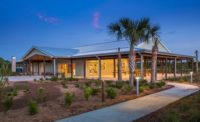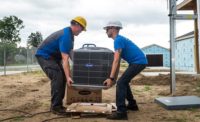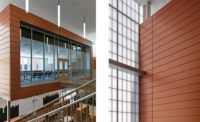Constructing its first ever net-zero energy house was not without challenges for Marc Rutenberg Homes, as the Florida-based luxury builder was intent on using sustainable materials that could garner the project a LEED Platinum certification and yet also remain true to the elegant Mediterranean aesthetic for which the company is known.
“We wanted luxury home-buying clients to come into this house and look at it as a presentation of livability and functionality and not to be sensitive to the way it actually operates,” explains Marc Rutenberg, president of Marc Rutenberg Homes. “If they walk through this house and say, ‘Gee, I expected it to be rather awkward or weird, and it is perfectly normal and gorgeous,’ then we can say we’ve done our job.”
The 4,552-square-foot home, known as Zero Energy America 1, was recently completed and is the first of four houses comprising Rutenberg’s ambitious Zero Energy America project in the Tampa Bay area, which draws on the company’s luxury building expertise to create high-end homes classified as net-zero energy.
In order to achieve sustainability goals for Zero Energy America 1, Rutenberg incorporated many materials not previously used by the longtime builder. “We knew from the beginning we wanted to reach a LEED Platinum certification, so that choice really governed many of our product decisions throughout the life of the project,” Rutenberg says. He and daughter Ashley Rutenberg, LEED AP Homes, project LEED AP, conducted assiduous research which led them to products ranging from the Boral Roofing clay tiles containing recycled content chosen for the roof to the high-performance, low-carbon Blue World Crete concrete selected for the floor system
“Zero Energy America’s first-generation home really started off with the concrete material itself,” Marc Rutenberg recounts. Blue World Crete concrete is a low carbon footprint alternative to Portland cement, as this product contains a proprietary catalyst/binding agent in place of quarried limestone. The concrete requires significantly less energy to produce than Portland cement and also causes much lower levels of carbon dioxide to be released into the atmosphere. “This is the first application of Blue World Crete concrete in the United States,” the builder says. “In order to use this product, we actually went through nine test labs to work through different formulations.”
The product selection process provided plenty of teachable moments for the Rutenberg team, including one lesson learned while choosing tiles for the roof. “The green building technical challenge on the roof was matching together the SRI values and the recycled content values,” Marc Rutenberg notes.
Though there are no hard-and-fast LEED requirements concerning residential roofs, Ashley Rutenberg looked to the commercial guidelines for guidance. “LEED New Construction (commercial buildings) requires an SRI of 29 for sloped roofs...so we decided to follow these same guidelines on the home, meeting an SRI of 29 or higher, and also meeting the LEED requirement of 50 percent pre-consumer recycled content,” she explains.
Boral tiles fit the project from both the sustainability and design aspects. “Made from the earth, Boral clay roofing products are all natural, 100 percent recyclable, with a recycled material content of up to 59 percent, minimizing the environmental footprint,” says John Renowden, vice president of technology at Boral Roofing. “Boral clay roofing products are unsurpassed in aesthetics and durability, and are covered by a transferable lifetime limited warranty that includes fade and labor coverage,” Renowden adds.
The color retention of clay tiles was a major selling point for Marc Rutenberg. However, the real lesson came when making his color selections. “We were looking at some of the Boral products, and we found out very quickly that the visual expectation of reflectives is very different from the technical values,” he recounts. As such, a decision was made to mix two Boral Clay 1-Piece “S” Tile roof color selections with 80 percent El Camino Blend and 20 percent Old World 1 in order to meet both the SRI of 29 or higher and the LEED recycled content requirement.
Color pairing also proved extremely effective for the home’s hardscape, as the Rutenberg team selected a combination of Boral pavers that allowed them to meet the LEED SRI requirement for lowering the local heat island effect and also made for an attractive design. A falling leaf design was achieved with the Heartland Flashed pavers, while the broader field area was laid with the Peachtree Avenue pavers. The combination of the Heartland Flashed SRI of 20–25 and the Peachtree Avenue SRI of 40–45 resulted in a point from LEED, which rewards the use of high-albedo surfaces on a home’s hardscape with an SRI of at least 29.
“Here again, we had to find color blending that allowed us to stay within the SRI limitations,” Marc Rutenberg notes. “The positive side was that there was someone at Boral who we could work with on creating the blend and verifying the technical components.”
Many of the companies that Rutenberg sought out proved to have extensive technical prowess, which was an invaluable asset on a project where the seasoned crew required specialized training at times, given that some of the materials incorporated into Zero Energy America 1 are rarely used in residential construction. The home’s exterior walls, for example, are comprised of Xella’s Hebel Aerated Autoclaved Concrete—a product that is primarily found in industrial and commercial buildings. “In order to complete the installation, Xella brought over trainers from their manufacturing facility and spent three days in the field with our masonry crew to train them on how to work with this product,” Marc Rutenberg says. The builder notes the product’s fire resistance, durability and energy efficiency as its virtues, though he does acknowledge that a significantly deeper trained labor pool is necessary for increasing its viability as a market replacement for conventional concrete block.
Xella’s Hebel Aerated Autoclaved Concrete has a higher thermal resistance than conventional concrete block, making it an integral component of this net-zero energy home. “What we used had an R-value of 12.5 and conventional rock has an R-value of about 1,” explains Ashley Rutenberg. “When you add conventional installation, you go to 5.4.”
Using the product meant interior finishes could be applied directly to the wall system, though this made electrical work a bit tricky. “We had to work out very creative ways to run the electrical work in many locations,” Marc Rutenberg recounts. “We had to find ways to run wiring at the base of the wall pipes, so we actually ran chasers through the wall...we drilled right into the material itself to create this passageway for all the wiring.”
In addition to Xella’s Hebel Aerated Autoclaved Concrete and Boral’s clay product, the builder also integrated PGT ENERGY STAR windows and French doors into the home to ramp up energy efficiency even further. Marc Rutenberg refers to the Solarban 60 window and door glazing in the house as “ENERGY STAR on steroids.”
The front door of Zero Energy America 1 is a prime example of the builder’s determination to achieve sustainability without sacrificing design integrity, as it features stunning heart cypress finishes from the Goodwin Company, a small manufacturer that specializes in river-recovered wood. The company recovers heart cypress and heart pine logs that were initially lost during transport on Florida’s rivers more than a century ago. “This is literally the wood that built America,” notes Carol Goodwin, president of the Goodwin Company. “All the old homes up and down the Mississippi in the 1700s and 1800s would have been made out of this prehistoric heart cypress, so our practices for conserving it and really just making sure that we are producing the best and highest yield intrigued Marc.” The builder also utilized the Goodwin Company’s wood for the home’s lanai and loggia ceilings.
A bevy of high-end green products also characterizes the interior of Zero Energy America 1, including Teragren stranded bamboo flooring, Columbia Forest Products’ Purebond cabinetry plywood and veneer with no added urea-formaldehyde, Mohawk carpet manufactured from 100 percent recycled plastic bottles, Oceanside Glasstile handcrafted bath tiles, ECO by Cosentino countertops created from 75 percent recycled content, and custom concrete countertops by Florida craftsman Jake Brady—whose facility is located just one hour from the home. “He was able to create extremely custom finishes, color and character—and all of the inlaid materials were 100 percent recycled glass,” says Marc Rutenberg of Brady. “Here, we were able to take a locally made product and build countertops that were aesthetically gorgeous and met the sustainability requirements,” he explains.
The completion of Zero Energy America 1 marks a major green accomplishment for Marc Rutenberg Homes, as it represents a significant shift in building practices for the company and its contractors. “Across the board, almost none of our contractors had experience in green building or the technical compliance demands that we were giving them,” Rutenberg notes. “Most all of them went from being interested students to being proud students in the end.
“The other major change that occurred was we went from a company that hadn’t recycled the first stick at an ordinary job site and we learned to dumpster dive very early in the project,” he adds. “To go from a group that had never recycled a lick to a project that recycled 95 percent of its construction debris was pretty amazing.”
“I think Marc is way ahead of the curve,” observes Goodwin about Rutenberg’s new focus on net-zero energy homes. “And not only is the sustainability and the durability of the home important to Marc, but so is its beauty. He understands that if you love your home, you are going to take care of it.”












